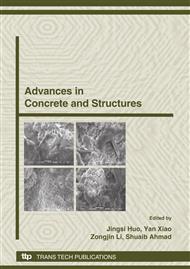[1]
J. F. Young, R.L. Berger and J. Breese, Accelerated Curing of Compacted Calcium Silicate Mortars on Exposure to CO2. Journal of the American Ceramic Society, Vol. 57, No. 9 (1974), p.394.
DOI: 10.1111/j.1151-2916.1974.tb11420.x
Google Scholar
[2]
J.M. Bukowskiand and R. L. Berger, Reactivity and Strength Development of Activated NonHydraulic Calcium Silicates. Cement and Concrete Research. Vol. 9 (1979), p.57.
DOI: 10.1016/0008-8846(79)90095-4
Google Scholar
[3]
C. J. Goodbrake, J. F. Young and R. L. Berger, Reaction of Beta-dicalcium Silicate and Tricalcium Silicate with Carbon Dioxide and Water Vapor. Journal of the American Ceramic Society, Vol. 62, No. 3 (1979), p.168.
DOI: 10.1111/j.1151-2916.1979.tb19046.x
Google Scholar
[4]
M. A. Sorochkin, A. F. Shchrov, I. A. Safonov, Study of the Possibility of Using Carbon Dioxide for Accelerating the Hardening of Products Made from Portland Cement. J. Appl. Chem. Vol. 48 (1975), p.1211.
Google Scholar
[5]
N. R. Short, P. Purnell and C. L. Page, Preliminary investigations into the Super-critical Carbonation of Cement Pastes. J. Mater. Sci., Vol. 36, No. 1 (2001), p.35.
Google Scholar
[6]
P. Purnell, N. R. Short and C. L. Page, Super-critical Carbonation of Glass Fiber Reinforced Cement: Part1. Mechanical Testing and Chemical Analysis. Composites Part A, Vol. 32, No. 12 (2001), p.1777.
DOI: 10.1016/s1359-835x(01)00019-7
Google Scholar
[7]
Y. Shao and C. Shi, Carbonation Curing for Making Concrete Products - An Old Concept and a Renewed Interest, Proceedings of the 6 th International Symposium on Cement and Concrete, Vol. 2 (2006), p.823.
Google Scholar
[8]
S. Monkman and Y. Shao, Assessing the Carbonation Behavior of Cementitious Materials. Journal of Materials in Civil Engineering,Vol. 18, No. 11 (2006), p.768.
DOI: 10.1061/(asce)0899-1561(2006)18:6(768)
Google Scholar
[9]
H. H. Steinour, Some Effects of Carbon Dioxide on Mortars and Concrete: A Discussion, Journal of the American Concrete Institute, Vol. 56, No. 4 (1959), p.905.
Google Scholar


